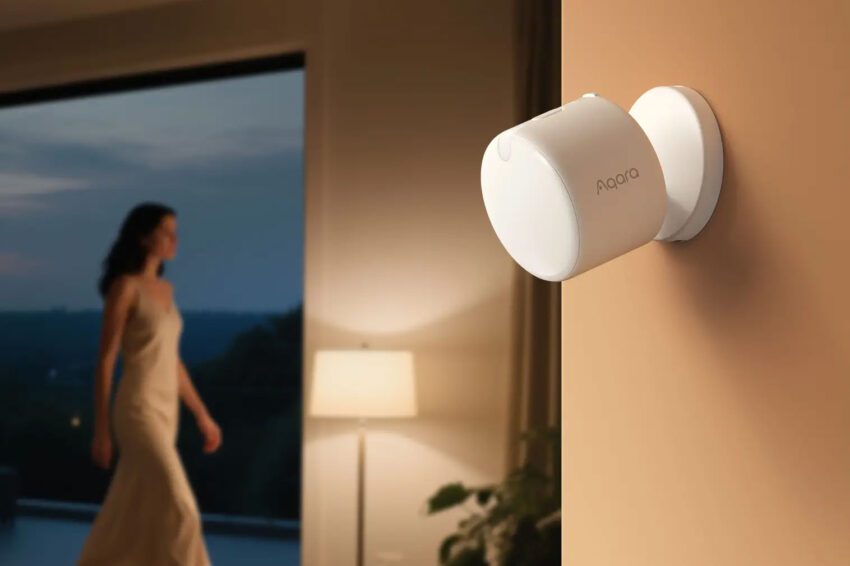
aqara s cord-free presence sensor runs for Aqara has unveiled its first battery-powered presence sensor, designed to enhance smart home automation by detecting the presence of individuals in various settings.
aqara s cord-free presence sensor runs for
Overview of the Aqara Presence Multi-Sensor FP300
The Aqara Presence Multi-Sensor FP300 is a versatile device that can be installed in virtually any location within a home, allowing for seamless automation of smart devices as family members come and go. This sensor is powered by two CR2450 coin cell batteries, providing a battery life of up to three years when connected to a Zigbee smart home setup. If users opt for the more advanced Thread protocol, the battery life is reduced to approximately two years. The FP300 is currently available for purchase at a price point of $49.99 through Amazon and Aqara’s official website.
Key Features
The FP300 is equipped with a combination of advanced technologies that enable it to detect both moving and stationary individuals. Utilizing passive infrared (PIR) and 60 GHz mmWave radar sensors, the device can identify people up to 20 feet away. This capability allows users to create automations that can turn on lights when someone enters a room or deactivate various smart home devices after a space has been unoccupied for a set period.
In addition to its presence detection features, the FP300 includes built-in sensors for temperature, humidity, and light levels. These additional functionalities enable users to automate climate control settings, ensuring comfort and energy efficiency throughout the home. For instance, the sensor can trigger air conditioning or heating systems based on the detected temperature, or adjust lighting based on ambient light levels.
Smart Home Integration
One of the standout features of the FP300 is its compatibility with multiple smart home platforms. The sensor supports both Zigbee and Matter over Thread protocols, making it versatile enough to work with popular ecosystems such as Apple Home, Google Home, Amazon Alexa, and Samsung SmartThings. This cross-compatibility allows users to integrate the FP300 into their existing smart home setups without needing to overhaul their systems.
Zigbee vs. Thread
While the FP300 can operate on both Zigbee and Thread, there are notable differences in performance and functionality between the two protocols. When using Zigbee, users benefit from a longer battery life, which can be crucial for maintaining the sensor’s functionality over extended periods without the need for frequent battery replacements. Additionally, the Aqara Home mobile app allows users to adjust the detection range of the FP300 when connected via Zigbee, providing greater flexibility in how the sensor is utilized.
Moreover, the app offers the option to disable individual sensors to further extend battery life, a feature that can be particularly useful in scenarios where certain detection capabilities are not required. For example, if a user only wants to monitor motion in a specific area, they can deactivate other sensors to conserve battery power.
Limitations of Battery Power
Despite its advantages, the transition to battery power does come with certain trade-offs. The FP300 does not offer some of the advanced features found in Aqara’s more expensive FP2 presence sensor. For instance, the FP300 lacks multi-person detection capabilities, which means it may not be as effective in environments where multiple individuals are present simultaneously. Additionally, features such as fall detection and real-time heart and respiratory rate monitoring during sleep are absent in the FP300. These limitations may influence consumers’ decisions, particularly those who require more comprehensive monitoring solutions.
Installation and Setup
Installing the FP300 is designed to be user-friendly, allowing homeowners to place the sensor in various locations without the constraints of power outlets. This flexibility means that the sensor can be positioned in hallways, living rooms, or even bedrooms, depending on the user’s needs. The absence of cords simplifies the installation process, making it accessible for individuals who may not be tech-savvy.
Once installed, users can easily set up the FP300 through the Aqara Home mobile app. The app guides users through the initial configuration process, including connecting the sensor to their chosen smart home platform. The intuitive interface allows for quick adjustments to settings, such as detection range and sensor activation, ensuring that users can tailor the device to their specific requirements.
Use Cases and Applications
The FP300’s capabilities lend themselves to a variety of practical applications within a smart home environment. Here are some potential use cases:
- Automated Lighting: The sensor can trigger lights to turn on automatically when someone enters a room, enhancing convenience and energy efficiency.
- Climate Control: By monitoring temperature and humidity, the FP300 can activate HVAC systems to maintain a comfortable living environment.
- Security Monitoring: The sensor can be integrated into a home security system, sending alerts when motion is detected in specific areas.
- Energy Management: Users can automate the shutdown of devices in unoccupied rooms, reducing energy consumption and lowering utility bills.
Market Context and Competition
The introduction of the FP300 comes at a time when the smart home market is rapidly evolving. With increasing consumer interest in home automation and energy efficiency, the demand for versatile and user-friendly devices is on the rise. Aqara’s decision to offer a battery-powered presence sensor aligns with this trend, providing a solution that meets the needs of modern homeowners.
However, the FP300 faces competition from other manufacturers offering similar products. Brands such as Philips Hue, Ring, and Wyze have also developed presence sensors and smart home devices that cater to a growing audience. As a result, Aqara must differentiate the FP300 through its unique features, pricing, and compatibility with various smart home ecosystems.
Stakeholder Reactions
The release of the FP300 has garnered attention from both consumers and industry experts. Early reviews highlight the sensor’s ease of installation and versatility, making it an attractive option for those looking to enhance their smart home setups. However, some potential buyers express concerns regarding the limitations in advanced features compared to higher-end models.
Industry analysts note that Aqara’s focus on battery-powered devices could resonate well with consumers seeking convenience and flexibility. The ability to install the FP300 without worrying about power sources may appeal to those who value aesthetics and practicality in their home design.
Conclusion
The Aqara Presence Multi-Sensor FP300 represents a significant advancement in the realm of smart home technology, offering a battery-powered solution that enhances automation and convenience. With its ability to detect both moving and stationary individuals, along with integrated temperature, humidity, and light sensors, the FP300 provides a comprehensive tool for modern homeowners. Its compatibility with multiple smart home platforms further solidifies its position in a competitive market.
As consumers increasingly seek ways to optimize their living spaces through technology, the FP300 stands out as a versatile option that balances functionality with ease of use. While it may not offer all the advanced features of more expensive models, its affordability and practicality make it a compelling choice for those looking to dip their toes into the world of smart home automation.
Source: Original report
Was this helpful?
Last Modified: November 12, 2025 at 10:38 pm
1 views















